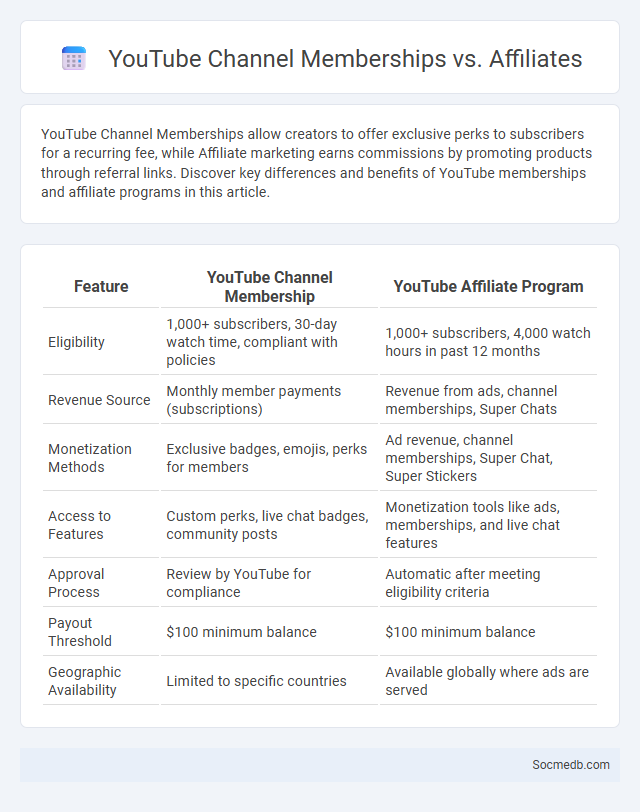
Photo illustration: YouTube Channel Membership vs Affiliates
YouTube Channel Memberships allow creators to offer exclusive perks to subscribers for a recurring fee, while Affiliate marketing earns commissions by promoting products through referral links. Discover key differences and benefits of YouTube memberships and affiliate programs in this article.
Table of Comparison
| Feature | YouTube Channel Membership | YouTube Affiliate Program |
|---|---|---|
| Eligibility | 1,000+ subscribers, 30-day watch time, compliant with policies | 1,000+ subscribers, 4,000 watch hours in past 12 months |
| Revenue Source | Monthly member payments (subscriptions) | Revenue from ads, channel memberships, Super Chats |
| Monetization Methods | Exclusive badges, emojis, perks for members | Ad revenue, channel memberships, Super Chat, Super Stickers |
| Access to Features | Custom perks, live chat badges, community posts | Monetization tools like ads, memberships, and live chat features |
| Approval Process | Review by YouTube for compliance | Automatic after meeting eligibility criteria |
| Payout Threshold | $100 minimum balance | $100 minimum balance |
| Geographic Availability | Limited to specific countries | Available globally where ads are served |
Introduction to YouTube Monetization Options
YouTube monetization offers various options such as ad revenue, channel memberships, Super Chat, and merchandise shelf integration that enable content creators to earn from their videos. Your channel must meet eligibility criteria, including 1,000 subscribers and 4,000 watch hours in the past 12 months, to access the YouTube Partner Program. Leveraging these monetization features helps maximize your revenue while engaging your audience effectively on the platform.
Understanding YouTube Channel Membership
YouTube Channel Membership allows creators to offer exclusive perks such as badges, emojis, and members-only content to subscribers for a monthly fee. This feature enhances audience engagement while providing a steady revenue stream for your channel. Understanding how to effectively use memberships can significantly grow your community and monetize your content.
What Are YouTube Affiliate Programs?
YouTube affiliate programs enable content creators to earn commissions by promoting products or services through unique referral links in their video descriptions. These programs connect YouTubers directly with brands, allowing You to monetize your channel by driving sales or leads from your audience. Leveraging affiliate marketing on YouTube boosts your income potential while providing valuable content to your viewers.
Key Features of Channel Membership
Channel Membership offers exclusive perks such as custom badges, emojis, and members-only videos, enhancing your interaction with creators. Members gain access to special live chats and behind-the-scenes content, fostering a closer community connection. This feature supports creators directly while providing personalized experiences that deepen your engagement on the platform.
Affiliate Marketing: How It Works on YouTube
Affiliate marketing on YouTube involves creators promoting products or services through unique tracking links in their video descriptions or content. When viewers click these links and make a purchase, creators earn commissions based on sales generated. Optimizing video tags, descriptions, and engaging content enhances visibility and conversion rates for affiliate marketing campaigns on the platform.
Earning Potential: Membership vs. Affiliates
Membership programs offer you recurring income by providing exclusive content or benefits to loyal followers, creating a steady revenue stream. Affiliate marketing earns commissions based on your ability to promote products or services, often resulting in variable but scalable earnings. Choosing between these strategies depends on your audience engagement and preferred income stability.
Engagement and Community Building Comparison
Social media platforms vary significantly in how they foster engagement and community building, with Instagram prioritizing visual content and frequent interaction through stories and comments, while Facebook offers robust group features that encourage deeper community connections and discussions. Twitter excels in real-time engagement, enabling rapid sharing and conversation around trending topics, whereas LinkedIn focuses on professional networking and industry-specific communities, promoting valuable connections and knowledge exchange. Understanding the unique strengths of each platform helps you tailor your content strategy to maximize engagement and cultivate a loyal, active community.
Eligibility and Requirements for Each Option
Social media platforms each have distinct eligibility criteria and requirements to create an account; for example, Facebook requires users to be at least 13 years old, while LinkedIn recommends professional information and work history to optimize profiles. Instagram also mandates a minimum age of 13 and encourages verified email or phone numbers for account security, whereas Twitter enforces age restrictions and limits the use of automated bots under its policies. Meeting these platform-specific requirements ensures compliance with community guidelines and enhances user experience across digital networks.
Pros and Cons: Membership vs. Affiliates
Social media memberships offer dedicated communities with exclusive content, fostering stronger brand loyalty and recurring revenue through subscription models. Affiliate marketing on social media leverages broad audience reach, driving sales via commission-based incentives without the need for content exclusivity or subscriber management. Membership demands consistent content creation and engagement to retain users, whereas affiliates face challenges in building trust and ensuring transparent promotion ethics.
Choosing the Best Monetization Strategy for Your Channel
Selecting the best monetization strategy for your social media channel depends on audience demographics, engagement levels, and content type. Popular options include sponsored posts, affiliate marketing, subscription models, and merchandise sales, each offering unique revenue potentials. Analyzing platform-specific tools like YouTube AdSense, Instagram Shopping, or TikTok Creator Fund helps maximize earnings tailored to your channel's strengths.
 socmedb.com
socmedb.com